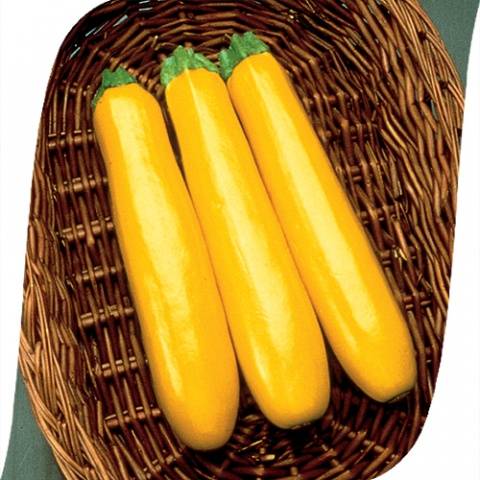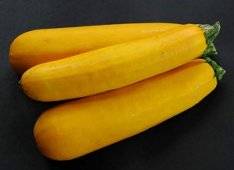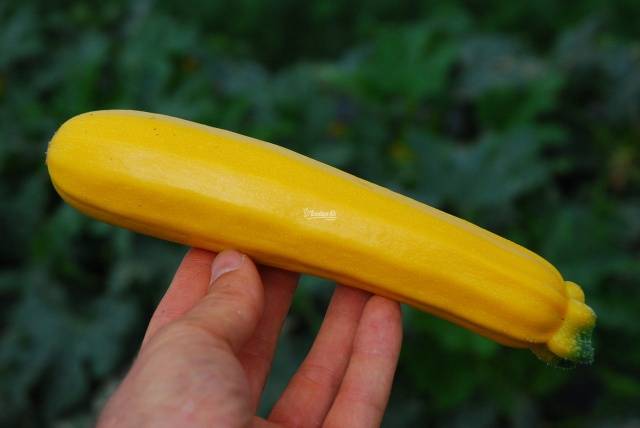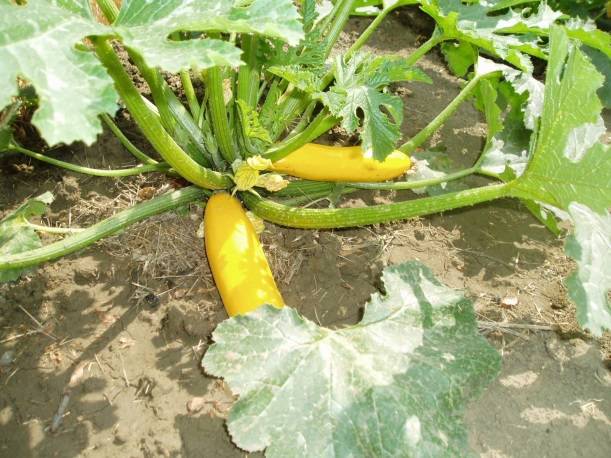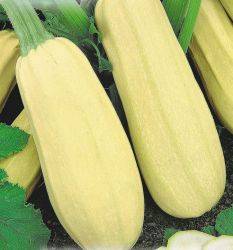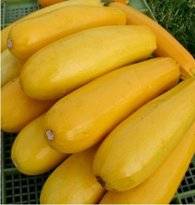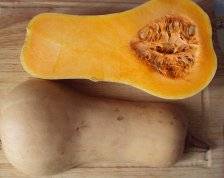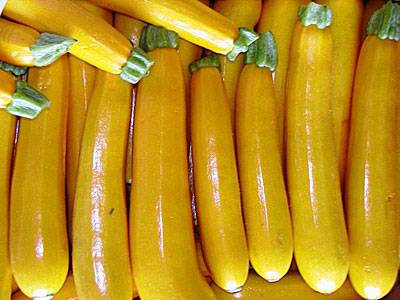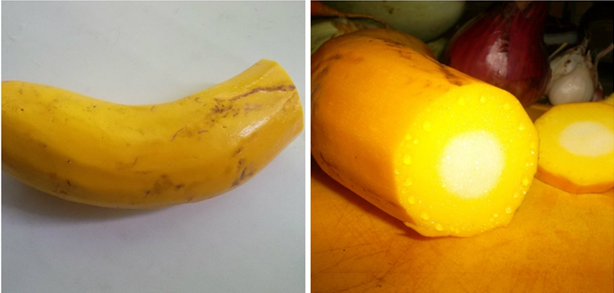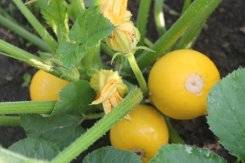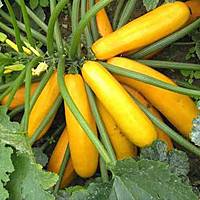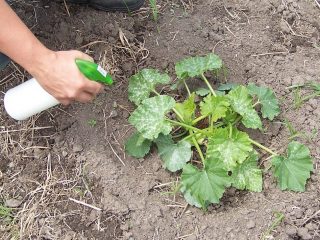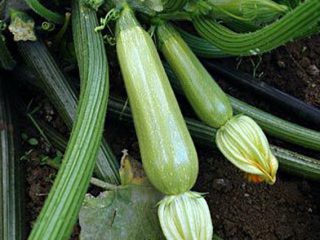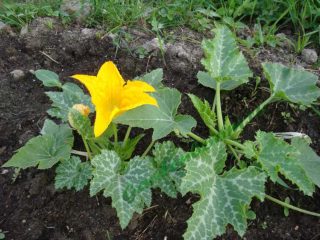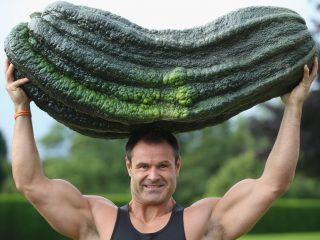Content
Yellow zucchini can become a real decoration of every vegetable garden. Its fruits with a shade from light yellow to orange not only look bright and original, but also taste great. The shape and size of different varieties also differ and sometimes surprise experienced gardeners. Growing yellow zucchini is no more difficult than green analogs. Due to their external and taste qualities, as well as their simplicity in care, these vegetables are becoming more and more popular.
For fresh consumption
There are a number of yellow zucchini that have an excellent taste: their flesh is crispy, juicy, sweetish. Due to such taste, the fruits of these varieties are recommended to be consumed raw, which makes them the most useful for the human body. The most popular varieties of yellow zucchini that are great for raw consumption are listed below.
Gold Rush F1
One of the most famous yellow zucchini. It has an amazing taste of the pulp: it is very tender, sweet, juicy. The size of the zucchini is small: length up to 320 cm, weight up to 200 g. The yield of the variety is quite high - up to 12 kg / m2... This allows not only eating vegetables raw, but also preserving them for the winter.
The plant is grown mainly in open areas. Seeds are sown in May, with a frequency of no more than 3 pcs / m2... The fruits of this Dutch hybrid are shown in the photo below.
Goldline F1
Czech hybrid, early ripening. From the moment the seed is sown to fruiting, a little over 40 days pass. The juicy, sweet flesh of this zucchini is great for eating raw.
Smooth fruits of golden yellow color do not exceed 30 cm in length.The yield of zucchini reaches 15 kg / m2... Seeds are planted in open areas in May.
Sunlight F1
This hybrid is a representative of the French selection. Zucchini fruits are small (up to 18 cm long, weighing up to 200 g). The surface of the vegetable marrow is smooth, cylindrical, golden yellow in color. Sowing seeds of this variety is recommended in May in open areas. The ripening period of fruits is 40-45 days.
The plant is very compact and can be planted at the rate of 4-6 bushes per 1 m2 soil. The yield of the variety reaches 12 kg / m2.
Raw zucchini is easy to digest, has a low calorie content and is part of many dietary meals. The trace element composition of yellow zucchini is characterized by a high content of carotene, potassium, magnesium, vitamins PP, C, B2, B6. Such benefits of vegetables, combined with excellent taste, make the above varieties especially valuable.
High-yielding varieties
Zucchini is an excellent preservative vegetable. Due to its neutral taste, not only pickles are prepared from it, but also jams and compotes. For winter harvesting, it is best to grow high-yielding varieties that will allow you to get enough vegetables in a small area of soil. The most productive among yellow zucchini are:
Yellow-fruited
Early ripening variety, the fruits of which ripen 45-50 days after sowing the seed. Grown outdoors, resistant to a number of diseases. With timely watering, top dressing and loosening, the yield of the variety can reach 20 kg / m2.
The plant is compact, with few leaves. Its seeds are sown in May-June. 1 m2 it is recommended to place no more than 3 zucchini in the soil.
The fruits of this variety are bright yellow, cylindrical in shape. The surface of the vegetable marrow is slightly ribbed and smooth. The pulp is firm, creamy. The average weight of one zucchini reaches 900 g.
Anchor
An early ripe variety, for the ripening of the fruits of which no more than 50 days are required from the day of sowing seeds in open ground. The crop is resistant to cold and drought, which allows you to get a yield of up to 15 kg / m2 regardless of weather conditions. Sowing seeds is recommended in May, harvesting lasts in this case until September.
The bush of this variety is compact, weakly branching. Recommended sowing frequency 4 plants per 1 m2.
The yellow zucchini of this variety are large, cylindrical in shape, weighing more than 900 g. Their surface is smooth, the skin is thin. A distinctive feature of the variety is the increased dry matter content in the pulp. A photo of this zucchini can be seen below.
Russian size
This variety is truly "Hercules" among all other zucchini. Its size amazes even experienced gardeners and farmers: the length of the vegetable marrow reaches 1 meter, its weight is up to 30 kg. With such a size of the fruit, it is even difficult to imagine what the yield of the plant as a whole can be. It takes about 100 days to ripen its fruits after sowing the seed.
Orange zucchini variety "Russian size" requires special growing conditions: at the end of April, the seeds are planted for seedlings. The plant is planted upon the onset of stable warm weather, without the threat of night frosts. Zucchini needs regular watering and feeding.
Zucchini have a pink-orange flesh, tender, without coarse fibers. Used for cooking and canning.
The given high-yielding varieties do not differ in high taste, however, the volume of fruits allows not only to prepare seasonal dishes from this vegetable, but also to prepare it for the winter in sufficient quantities.
Fancy yellow zucchini
Yellow zucchini are capable of striking not only with a unique, excellent taste or size of the crop, but also with the original shape of the fruit. Surprising your neighbors will probably turn out to be zucchini of the following varieties:
Pear-shaped
An early ripe variety, the fruits of which outwardly resemble a large pear. The uniqueness of such zucchini is that the seeds are concentrated in the lower part of the fruit, and most of the pulp does not contain them at all.
Zucchini is yellow, up to 23 cm long, weighing up to 1.3 kg. Its rind is very thin, not coarse. The pulp has an exceptional aroma, juicy, dense, orange in color.
The culture is grown in the open field. It takes just over 50 days for the fruit to ripen. You can evaluate the external qualities of the zucchini by looking at the photo below.
Banana
Who said bananas don't grow in mid-latitude? They are perfectly adapted to our latitudes, considering that "Banana" is a kind of zucchini.
Before the onset of biological maturity, the fruits of this variety do not contain a seed chamber, which can be seen in the photo below. Young zucchini are very juicy, crunchy, sweet, with a specific aroma and flavor.
Scourges of this plant can reach 3-4 meters, so the sowing frequency should not exceed 1 bush per 1 m2 soil. Vegetable up to 70 cm long, ripens 80 days after sowing the seed. However, as a rule, it is consumed before it is fully ripe. A feature of the variety is its excellent keeping quality, which allows you to store zucchini for a long time without processing.
Spaghetti
Zucchini of this variety is not so much surprising in its appearance as in its inner filling: their pulp looks like spaghetti, which gives the chefs the opportunity to show their culinary imagination in the preparation of some dishes. You can see an example of such a unique fruit in the photo below.
Outwardly, the fruit has a smooth, cylindrical shape, colored yellow. The length of the zucchini reaches 30 cm, the weight is about 1.5 kg.The disadvantage of this variety is its rough, hard rind.
Bush plant with long lashes. For the ripening of the fruits of this variety, it takes more than 110 days from the day of sowing the seed. The fruiting period is quite long until September. The culture is grown mainly in the open field.
The analogue of this variety is the yellow squash of the Spaghetti Raviolo variety. Their flesh also has a unique look.
Orange
Another "fruit" in the garden can be a hybrid of Orange F1. This name, first of all, demonstrates the external quality of the zucchini: yellow round, up to 15 cm in diameter. The variety is early ripening. Its fruits ripen 40 days after sowing the seed. Productivity reaches 6 kg / m2... The unique sweetish taste, juiciness of the pulp, allows you to consume the vegetable in a fresh, unprocessed form.
You can find out more about the cultivation of this variety in the video:
Pineapple
A variety of yellow zucchini that allows you to prepare a vegetable in such a way that its taste and appearance will resemble canned pineapples. Its pulp is dense, juicy, crunchy, with a sweetish aftertaste. Zucchini are ripened 40-45 days after sowing the seed.
Bush plant, without lashes. Sown at the rate of 3 bushes per 1 m2 soil. The yield of the variety reaches 10 kg / m2.
Conclusion
Yellow zucchini are widespread in our gardens. In addition to the well-known and unique varieties listed above, there are other varieties, for example, Atena Polka F1, Buratino, Zolotinka, Yellow stars, Golden and others. They do not have any special original differences in shape or taste, but they are perfectly adapted to growth in middle climatic latitudes and are capable of producing quite a decent harvest.
For information on how to properly grow a rich crop of tasty, healthy yellow zucchini, see the video guidelines:

